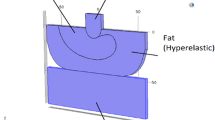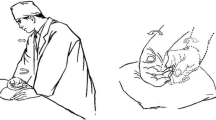Abstract
Deep tissue injury (DTI) is a severe kind of pressure ulcers formed by sustained deformation of muscle tissues over bony prominences. As a major clinical issue, DTI affects people with physical disabilities, and is obviously related to the load-bearing capacity of muscle cells in various in vivo conditions. It has been hypothesized that oxidative stress, either induced by reperfusion immediately following tissue unloading or in chronic inflammatory conditions, may affect the cellular capacity against subsequent mechanical damages. In this study, we measured the compressive damage threshold of C2C12 mouse myoblasts with or without pre-treatment of hydrogen peroxide as an oxidative agent to understand how changes in the oxidative environment may contribute to the development of DTI. Spherical indentation was applied onto a layer of agarose gel (3 mm thick) covering a monolayer of C2C12 myoblasts. Cell damage was recognized by using a cell membrane damage assay, propidium iodide. The spatial profile of the measured percentage cell damage was correlated with the radially varying stress field as determined by finite element analysis to estimate the compressive stress threshold for cell damage. Results supported the hypothesis that chronic exposure to high-dosage oxidative stress could compromise the capability of muscle cells to withstand compressive damages, while short exposure to low-dosage oxidative stress could enhance such capability.







Similar content being viewed by others
References
Allman, R. M., P. S. Goode, N. Burst, A. A. Bartolucci, and D. R. Thomas. Pressure ulcers, hospital complications, and disease severity: impact on hospital costs and length of stay. Adv. Skin Wound Care 12(1):22–30, 1999.
Allman, R. M., P. S. Goode, M. M. Patrick, N. Burst, and A. A. Bartolucci. Pressure ulcer risk factors among hospitalized patients with activity limitation. Jama 273(11):865–870, 1995.
Anderson, J. E. A role for nitric oxide in muscle repair: nitric oxide–mediated activation of muscle satellite cells. Mol. Biol. Cell. 11(5):1859–1874, 2000.
Bader, D. L., C. Bouten, D. Colin, and C. W. J. Oomens. Pressure Ulcer Research: Current and Future Perspectives. New York: Springer, 2005.
Bogie, K. M., I. Nuseibeh, and D. L. Bader. Early progressive changes in tissue viability in the seated spinal cord injured subject. Spinal Cord 33(3):141–147, 1995.
Breuls, R. G. M., C. V. C. Bouten, C. W. J. Oomens, D. L. Bader, and F. P. T. Baaijens. Compression induced cell damage in engineered muscle tissue: an in vitro model to study pressure ulcer aetiology. Ann. Biomed. Eng. 31(11):1357–1364, 2003.
Breuls, R. G. M., A. Mol, R. Petterson, C. W. J. Oomens, F. P. Baaijens, and C. V. Bouten. Monitoring local cell viability in engineered tissues: a fast, quantitative, and nondestructive approach. Tissue Eng. 9(2):269–281, 2003.
Byrne, D. W., and C. A. Salzberg. Major risk factors for pressure ulcers in the spinal cord disabled: a literature review. Spinal Cord 34:255–263, 1996.
Choudhury, N. A., S. Sakaguchi, K. Koyano, A. F. M. Matin, and H. Muro. Free radical injury in skeletal muscle ischemia and reperfusion. J. Surg. Res. 51(5):392–398, 1991.
Coleman, B. D., and D. C. Newman. On the rheology of cold drawing. II. Viscoelastic materials. J. Polym. Sci. Part B: Polym. Phys. 30(1):25–47, 1992.
Coleman, S., J. Nixon, J. Keen, L. Wilson, E. McGinnis, C. Dealey, N. Stubbs, A. Farrin, D. Dowding, J. M. G. A. Schols, J. Cuddigan, D. Berlowitz, E. Jude, P. Vowden, L. Schoonhoven, D. L. Bader, A. Gefen, C. W. J. Oomens, and E. A. Nelson. A new pressure ulcer conceptual framework. J. Adv. Nurs. 70(10):2222–2234, 2014.
Deseri, L., M. Fabrizio, and M. Golden. The concept of a minimal state in viscoelasticity: new free energies and applications to PDEs. Arch. Ration. Mech. Anal. 181(1):43–96, 2006.
Federico, A., F. Morgillo, C. Tuccillo, F. Ciardiello, and C. Loguercio. Chronic inflammation and oxidative stress in human carcinogenesis. Int. J. Cancer. 121(11):2381–2386, 2007.
Gawlitta, D., W. Li, C. W. J. Oomens, F. P. Baaijens, D. L. Bader, and C. V. Bouten. The relative contributions of compression and hypoxia to development of muscle tissue damage: an in vitro study. Ann. Biomed. Eng. 35(2):273–284, 2007.
Gefen, A., B. van Nierop, D. L. Bader, and C. W. J. Oomens. Strain-time cell-death threshold for skeletal muscle in a tissue-engineered model system for deep tissue injury. J. Biomech. 41(9):2003–2012, 2008.
Gissel, H. The role of Ca2+ in muscle cell damage. Ann. N. Y. Acad. Sci. 1066(1):166–180, 2006.
Linder-Ganz, E., S. Engelberg, M. Scheinowitz, and A. Gefen. Pressure–time cell death threshold for albino rat skeletal muscles as related to pressure sore biomechanics. J. Biomech. 39(14):2725–2732, 2006.
Linder-Ganz, E., and A. Gefen. Mechanical compression induced pressure sores in rat hindlimb: muscle stiffness, histology, and computational models. J. Appl. Physiol. 96:2034–2049, 2004.
Linder-Ganz, E., and A. Gefen. Stress analyses coupled with damage laws to determine biomechanical risk factors for deep tissue injury during sitting. J. Biomech. Eng. 131.1:011003, 2009.
Liochev, S. I. Reactive oxygen species and the free radical theory of aging. Free Radic. Biol. Med. 60:1–4, 2013.
Mak, A. F. T., Y. Y. Yu, L. P. C. Kwan, L. Sun, and E. W. C. Tam. Deformation and reperfusion damages and their accumulation in subcutaneous tissues during loading and unloading: a theoretical modeling of deep tissue injuries. J. Theor. Biol. 289:65–73, 2011.
Mak, A. F. T., M. Zhang, and E. W. C. Tam. Biomechanics of pressure ulcer in body tissues interacting with external forces during locomotion. Annu. Rev. Biomed. Eng. 12:29–53, 2010.
McNeil, P. Membrane repair redux: redox of MG53. Nat. Cell. Biol. 11:7–9, 2009.
Ogden, R. W. Large deformation isotropic elasticity-on the correlation of theory and experiment for incompressible rubberlike solids. Proc. R. Soc. Lond. A. 326(1567):565–584, 1972.
Oomens, C. W. J., S. Loerakker, and D. L. Bader. The importance of internal strain as opposed to interface pressure in the prevention of pressure related deep tissue injury. J. Tissue Viability 19(2):35–42, 2010.
Peeters, E. A. G., C. W. J. Oomens, C. V. C. Bouten, D. L. Bader, and F. P. T. Baaijens. Mechanical and failure properties of single attached cells under compression. J. Biomech. 38(8):1685–1693, 2005.
Peirce, S. M., T. C. Skalak, and G. T. Rodeheaver. Ischemia-reperfusion injury in chronic pressure ulcer formation: a skin model in the rat. Wound Repair Regen. 8(1):68–76, 2000.
Pullarkat, P. A., P. A. Fernández, and A. Ott. Rheological properties of the eukaryotic cell cytoskeleton. Phys. Rep. 449(1):29–53, 2007.
Rahman, K. Studies on free radicals, antioxidants, and co-factors. Clin. Interv. Aging. 2(2):219, 2007.
Siu, P. M., E. W. Tam, B.T. Teng, X.M. Pei, J.W. Ng, I.F. Benzi, and A.F. Mak. Muscle apoptosis is induced in pressure-induced deep tissue injury. J. Appl. Physiol. 107:1266–1275, 2009.
Siu, P. M., Y. Wang, and S. E. Alway. Apoptotic signaling induced by H2O2-mediated oxidative stress in differentiated C2C12 myotubes. Life Sci. 84(13):468–481, 2009.
Slomka, N., S. Or-Tzadikario, D. Sassun, and A. Gefen. Membrane-stretch-induced cell death in deep tissue injury: computer model studies. Cell Mol. Bioeng. 2(1):118–132, 2009.
Solis, L. R., A. Liggins, R. R. Uwiera, N. Poppe, E. Pehowich, P. Seres, R. B. Thompson, and V. K. Mushahwar. Distribution of internal pressure around bony prominences: implications to deep tissue injury and effectiveness of intermittent electrical stimulation. Ann. Biomed. Eng. 40(8):1740–1759, 2012.
Stroetz, R. W., N. E. Vlahakis, B. J. Walters, M. A. Schroeder, and R. D. Hubmayr. Validation of a new live cell strain system: characterization of plasma membrane stress failure. J. Appl. Physiol. 90(6):2361–2370, 2001.
Sun, S., S. Wong, A. Mak, and M. Cho. Impact of oxidative stress on cellular biomechanics and the rho signaling in C2C12 myoblasts. J. Biomech. 47(15):3650–3656, 2014.
Warren, G. L., M. Summan, X. Gao, R. Chapman, T. Hulderman, and P. P. Simeonova. Mechanisms of skeletal muscle injury and repair revealed by gene expression studies in mouse models. J. Physiol. 582(2):825–841, 2007.
Wong, S. W., S. Sun, M. Cho, K. K. Lee, A. F. T. Mak. H2O2 exposure affects myotube stiffness and actin filament polymerization. Ann. Biomed. Eng. 1–11, 2014.
Wozniak, M. A., and C. S. Chen. Mechanotransduction in development: a growing role for contractility. Nat. Rev. Mol. Cell Biol. 10(1):34–43, 2009.
Xiao, D. Z. T., S. Y. Q. Wu, and A. F. T. Mak. Accumulation of loading damage and unloading reperfusion injury—modeling of the propagation of deep tissue ulcers. J. Biomech. 47(7):1658–1664, 2014.
Acknowledgments
This study was supported by Hong Kong Research Grant Council (RGC Ref. No.: CUHK415413).
Conflict of interest
The authors of the above paper state that they have no conflict of interest.
Author information
Authors and Affiliations
Corresponding author
Additional information
Associate Editor Amit Gefen oversaw the review of this article.
Rights and permissions
About this article
Cite this article
Yao, Y., Xiao, Z., Wong, S. et al. The Effects of Oxidative Stress on the Compressive Damage Thresholds of C2C12 Mouse Myoblasts: Implications for Deep Tissue Injury. Ann Biomed Eng 43, 287–296 (2015). https://doi.org/10.1007/s10439-014-1239-6
Received:
Accepted:
Published:
Issue Date:
DOI: https://doi.org/10.1007/s10439-014-1239-6




